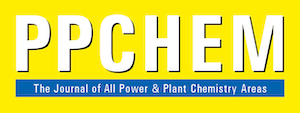
For members only
ABSTRACTS
Corrosion Issues Caused by Changes in Pipe Cross-Sections
Andrés Rodríguez Pérez
Among the most detrimental corrosion phenomena observed in the power industry are those related to a sudden expansion of a fluid beyond the saturation point. The effects of such types of corrosion may be particularly aggressive due to a combination of physical factors and a variety of chemical mechanisms that could potentially be involved. Based on data collected from over one hundred inspections carried out in the power industry and refineries, this publication is aimed at building a stronger understanding of the issues to allow plant operators to predict areas of vulnerability, mitigate the risk of potential failures, and specify a correct chemical treatment program to operate their plant at its maximum level of performance and reliability.
PPCHEM® 2020, 22(2), 66–72
For Members only
Chloride Contamination of the Water/Steam Cycle in Power Plants: Part VII. Final Verdict on Vapor Ingress of Chlorinated Compounds via Weak Tube/Tubesheet Joints
Emmanuel K. Quagraine, Trever McNabb, Suzanne McNabb, Sheldon McNabb, Taneal Weiss, Gillian Bailey, Ashley Ponak, Brenna Janzen, and Janet Meyers
This paper concludes a series of publications on investigations at Shand Power Station (SaskPower) to understand selective chloride cycling in this plant. With naval brass tubesheet, dezincification was implicated as the corrosion mechanism at naval brass tube-to-tubesheet joints, which created vapor pathways for recirculating cooling water (RCW) chlorine compounds into the water/steam circuit, eventually forming chlorides. Replacing the tubesheet with Duplex 2507 SS, the expectation was that the chloride cycling would end. Yet it persisted. The paper provides evidence that even with new metallurgies, vapor ingress via weak tube-to-tubesheet joints has mainly been responsible for the persisting chloride cycling. Organochlorine compounds leaching from the tubesheet/shell interface gasket have also been shown to potentially contribute to the chloride cycling, to a major extent earlier on, but becoming less significant over time. Plugging of the leaking tubes at tube-to-tubesheet joints reduced the average daily increases in boiler chloride from 28.4µg⋅L–1 to 2.7µg⋅L–1, supporting the notion that the RCW was the principal source of the chloride contamination.
PPCHEM® 2020, 22(2), 74–90

